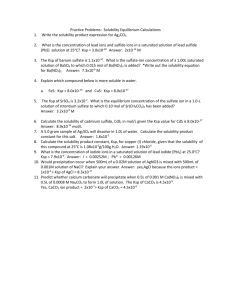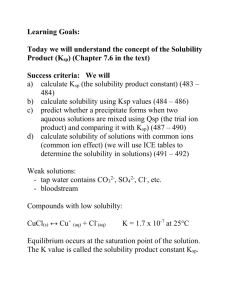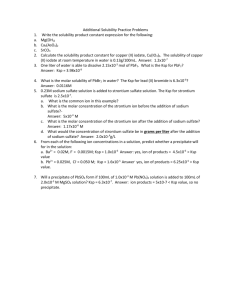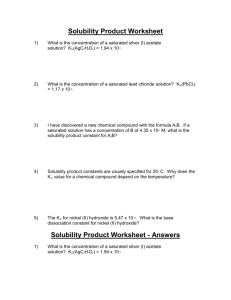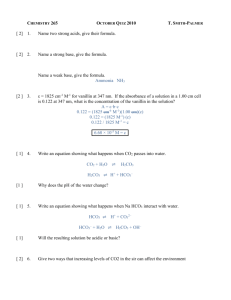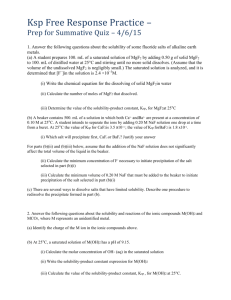Lesson: Solubility equilibrium and the Solubility Product
advertisement
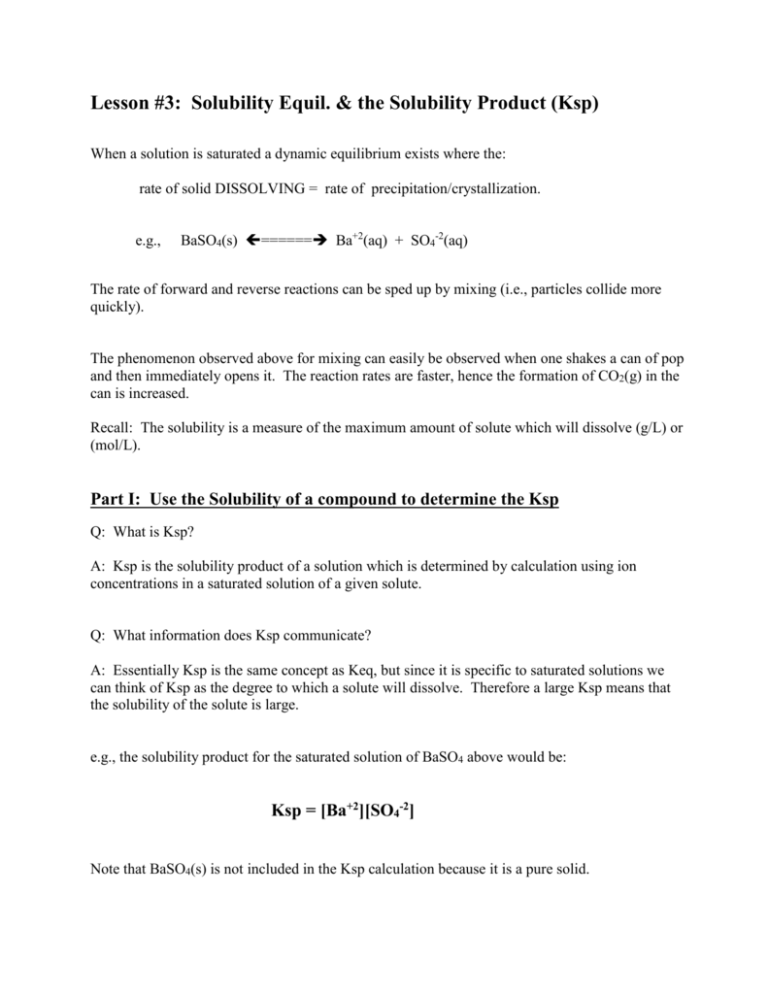
Lesson #3: Solubility Equil. & the Solubility Product (Ksp) When a solution is saturated a dynamic equilibrium exists where the: rate of solid DISSOLVING = rate of precipitation/crystallization. e.g., BaSO4(s) ====== Ba+2(aq) + SO4-2(aq) The rate of forward and reverse reactions can be sped up by mixing (i.e., particles collide more quickly). The phenomenon observed above for mixing can easily be observed when one shakes a can of pop and then immediately opens it. The reaction rates are faster, hence the formation of CO2(g) in the can is increased. Recall: The solubility is a measure of the maximum amount of solute which will dissolve (g/L) or (mol/L). Part I: Use the Solubility of a compound to determine the Ksp Q: What is Ksp? A: Ksp is the solubility product of a solution which is determined by calculation using ion concentrations in a saturated solution of a given solute. Q: What information does Ksp communicate? A: Essentially Ksp is the same concept as Keq, but since it is specific to saturated solutions we can think of Ksp as the degree to which a solute will dissolve. Therefore a large Ksp means that the solubility of the solute is large. e.g., the solubility product for the saturated solution of BaSO4 above would be: Ksp = [Ba+2][SO4-2] Note that BaSO4(s) is not included in the Ksp calculation because it is a pure solid. Practice: Write the Ksp expression for a saturated solution of Ca(OH)2. Ca(OH)2 ==== Ca+2(aq) + 2OH-(aq) Ksp = [Ca+2][OH-]2 Exercises: 1. The solubility of silver bromide, AgBr, is found to be 8.8 x 10-7 mol/L. Calculate the Ksp. Step #1: Write the dissociation equation (always put the solid on the left when calculating Ksp) AgBr(s) ===== Ag+(aq) + Br-(aq) Step #2: Write the Ksp expression. Ksp = [Ag+][Br-] Step #3: Determine the concentration of the aqueous ions. Since ions are in 1:1 ratio with the solid the [Ag+] = [Br-] = 8.8 x 10-7M Step #4: “Sub-in” and solve for Ksp. Ksp = [8.8 x 10-7M ][ 8.8 x 10-7M ] = 7.7 x 10-13 (NO UNITS!) 2. The solubility of magnesium hydroxide, Mg(OH)2, is found to be 1.3 x 10-4M . Calculate the Ksp. Mg(OH)2(s) === Mg+2(aq) + 2OH-(aq) Ksp = [Mg+2][OH-]2 Ratio is 1:2 with the solid, therefore the [Mg+2] = 1.3 x 10-4M and the [OH-] = 2.6 x 10-4M Ksp = [1.3 x 10-4M][ 2.6 x 10-4M ]2 = 8.8 x 10-12 Part II: Using the Ksp to calculate the solubility of a given compound. (i.e., the reverse of what we were doing in part I). 1. Calculate the solubility of CaCO3 at 25oC. [Note: When standard conditions apply (25oC), the Ksp value from the data booklet may be used unless the Ksp is given in the question] Step #1: Write the dissociation equation CaCO3(s) ==== Ca+2(aq) + CO3-2(aq) Step #2: Write the Ksp expression Ksp = [Ca+2][CO3-2] Step #3: Determine the mole ratio and apply appropriate “Let statements” When CaCO3 dissolves the ratio of ions is 1: 1. Therefore the [Ca+2] = [CO3-2] =x Step #4: Plug in known and unknowns (from Let statements) and solve. 5.0 x 10-9 = (x)(x) 5.0 x 10-9 = x2 7.1 x 10-5M = x =[Ca+2] = [CO3-2] Step #5: Use a ratio to state the solubility of the solid. Since ion concentrations are 1:1 with the solid, the solubility of CaCO3 must be 7.1 x 10-5M 2. The Ksp for MgF2 has a value of 6.4 x 10-9. What is the solubility of the compound in g/L? MgF2(s) ===== Mg+2(aq) + 2F-(aq) Ksp = [Mg+2][F-]2 Note: The Ksp value must be used in the question because we may not assume that standard conditions apply! When MgF2 dissolves the ratio of ions is 1:2, therefore the [Mg+2] = x and [F-] = 2x 6.4 x 10-9 = (x)(2x)2 6.4 x 10-9 = 4x3 𝟑 𝟑 √𝟏. 𝟔 𝐱 𝟏𝟎−𝟗 = √𝐱 𝟑 1.2 x 10-3M = x = [Mg+2] Since the ratio of [Mg+2] to MgF2(s) is 1:1, then the solubility of MgF2(s) = 1.2 x 10-3M Note: We must convert to g/L which involves converting moles to mass. (i.e., use the molar mass of MgF2) 𝟔𝟐.𝟑𝐠 𝟏.𝟎𝐦𝐨𝐥 = 𝐱 −𝟑 𝟏.𝟐 𝐱 𝟏𝟎 𝐦𝐨𝐥 x = 7.3 x 10-2g Therefore the solubility of MgF2 is 7.3 x 10-2g/L

